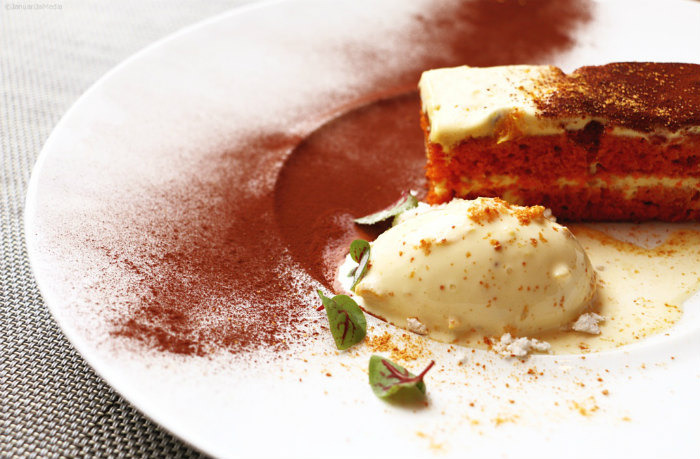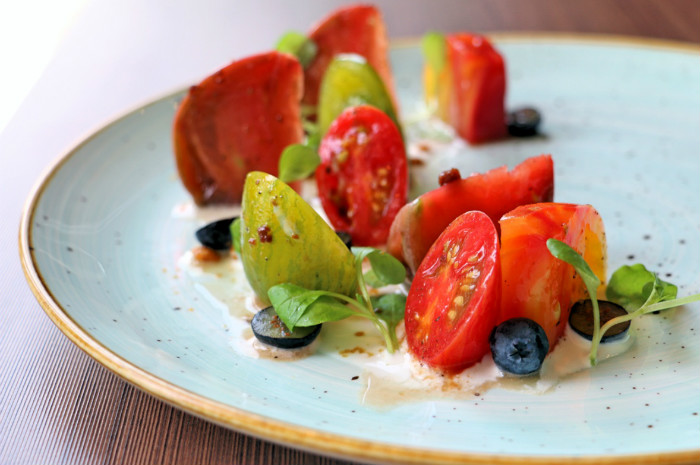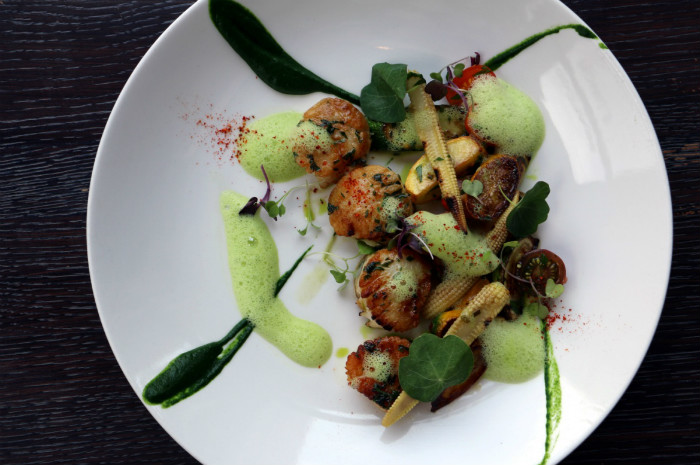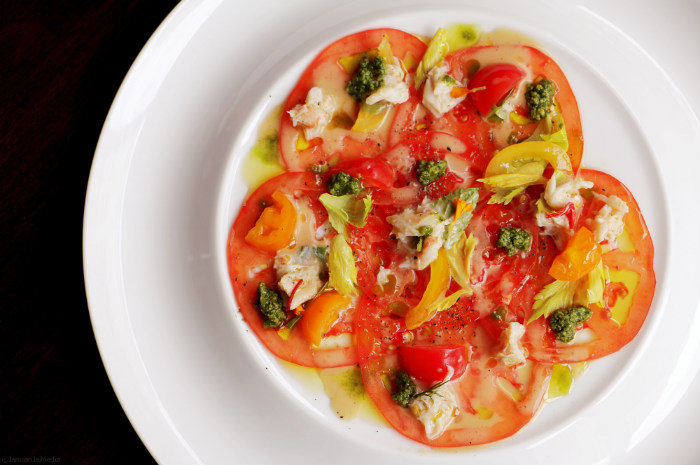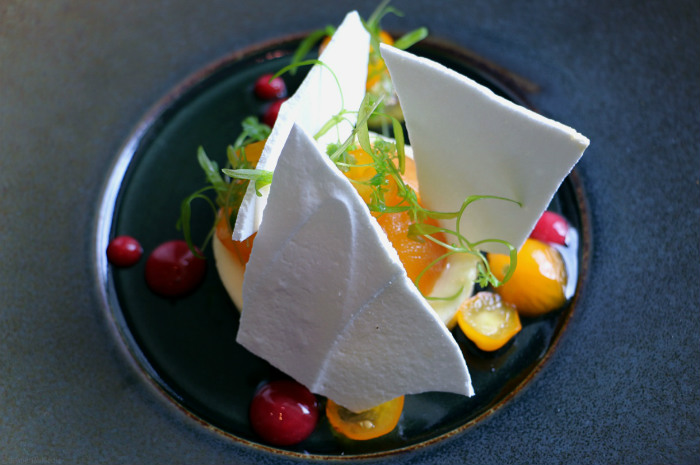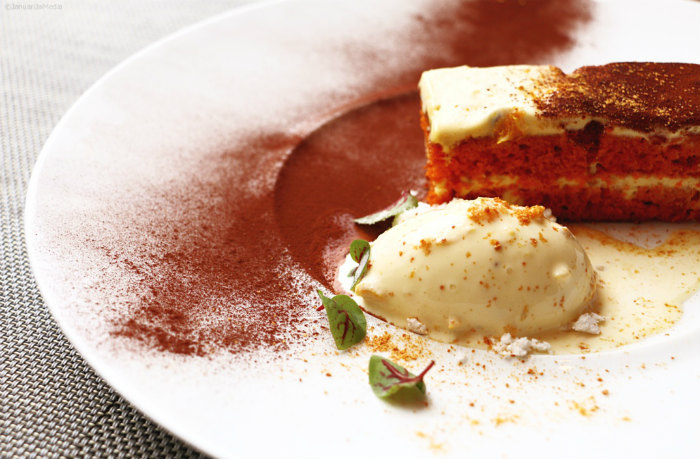Along The Knightsbridge Tomato Trail In Washington, DC
All photos by Jai Williams.
In the Chesapeake Bay region, August means two things: an abundance of heirloom tomato varieties in every size, shape, and color, and the arrival of thirty-one uninterrupted days of sensuous summer pleasure. When not eating tomatoes, hedonist foodies long for them, gazing wistfully at them in farmers markets or secretly coveting them in their neighbor's garden. Even ambivalent eaters daydream about the chance for stolen moment of languid pleasure and the tentative first bite of the crimson tomato's burnished flesh.
Minimalists prefer their berry nude with just a whisper of sea salt and conventional lovers serve tomatoes in fresh, colorful salads alongside pungent greens, extra virgin olive oil, and a range of red or white wine vinegars.
The Tomato's Appeal
What is it that makes people so enraptured with the tomato? Maybe it's the way the tomato's firm yet yielding orb reveals a juicy core that's bursting with flavor. Or, it could be the tomato's duality of sweet and savory aromas that make even sweetly scented strawberries seem pale and mewling in comparison. Whatever the attraction, we can say with certainty that flavorless, mealy, piqued supermarket tomatoes are not what are on everyone's minds. What people crave are less-than-perfect, appetizing, GMO- and pesticide-free heirloom tomatoes with deep earthy aromas and flavors—these are the qualities that have made the tomato an essential ingredient in cuisines as far flung from The States as China and India.
You Say "Vegetable," Botanists Say "Fruit"
Cooks adore the tomato because its kaleidoscopic blend of tangy, sweet, tender, meaty qualities lends complexity and nuance to any dish. Many cooks mistakenly call the tomato a vegetable but this confusion is forgiven since the tomato has many guises and can play many parts. Its red, gold, brown, green, purple, and orange color palette gives it the versatility to be both a minor and major player in stocks, sauces, soups, sautés, and side dishes and it pairs well with other seasonal fruit and vegetables.
In spite of the layman's view that the tomato is a vegetable, botanists have a less romantic opinion. Science tells them the tomato begins as a flower and later produces seeds, and anyone who has taken even a rudimentary botany class can tell you that's a sure sign the tomato is a fruit and not a vegetable. Nevertheless, even scientists succumb to the tomato's charms. Could it be this prolific, sun-loving fruit's complex blend of sugars and compounds that offer endless hours of tasty research?
The Tomato's Scentsability
What makes the tomato such a unique fruit is that no single volatile compound gives the fruit its special aromas and flavors. In fact, several hundred volatile compounds make up the flavor and scent profile of a ripe tomato (including the very aromatic stems and leaves), and humans can only detect about 15 to 20 of the most concentrated compounds. However, when compared to the one or two compounds that give a banana its individual flavor one sees why, over the centuries, the tomato has become such a highly prized cooking ingredient. Try smelling the tomato, stem, and leaves and see if you can identify specific aromas and flavors. It's likely you will detect floral scents like rose petals, green aromas like freshly cut grass, spicy notes of white and black pepper, and even sweet tropical fruit.
A Connoisseur of Fine Tomatoes
While less imaginative chefs may simply use the tomato in quick sauces or sautés, there are chefs that embrace tomato season happily and are inspired to create original dishes that elevate it to new heights. And we have Ashok Bajaj to thank for five of the most singular and inventive expressions of tomato art on offer this season.
Ashok Bajaj is a discriminating restaurateur with an impeccable eye for quality. He pursues excellence in all things, and to capture the tomato's brief moment of seasonal beauty, he wisely had chefs at five of his Knightsbridge Restaurant Group's restaurants create tomato-centric menus that celebrate this fruit throughout August. Each chef has put his stamp on original, and brilliantly executed dishes at 701, Ardeo + Bardeo, Bibiana, NoPa Kitchen + Bar, and Oval Room. We were lucky enough to taste each dish and discover the inspiration behind each one. We hesitate to use the word genius too liberally, but in this case, it fits. Dash over there to taste each before they disappear with the waning of the season or you will miss this spectacular dining experience.
Ardeo + Bardeo
When Ardeo+Bardeo executive chef Jonathan Dearden says his tomatoes are local, he means it. The cherry tomatoes featured in his heirloom tomato salad are grown on the restaurant's roof and he sources his cheese, fruits, and vegetables locally from fastidious purveyors. Each ingredient is bright and saturated with jewel tones of ruby, emerald, and lapis and while the salad may feature only a few select ingredients, each one is alive on your palate. Chef Dearden has captured the essence of a summer garden in his blend of pickled blueberries, mâche, plum, Burbank, sun gold, and red blush tomatoes. A delicate sun-dried tomato and balsamic vinaigrette includes extra virgin olive oil, garlic, and shallots enhances the aromas and tastes of each ingredient. This dish is proof it takes an artist to elevate a simple tomato salad to a color splash of impressionist art that tastes as beguiling and fresh as it looks. It can easily take pride of place as the overture to any meal.
NoPa Kitchen + Bar
Matt Kuhn, the executive chef at NoPa Kitchen + Bar has Southern roots that run deep and his playful tomato dish evokes nighttime cookouts on the beach with just caught seafood, sweet corn, and juicy tomatoes. The pan roasted scallops fill the room with the scents of fresh sea air and the scallops' sweet, caramelized notes harmonize easily with the sugary roasted patty pan squash, roasted sun gold tomatoes, and nasturtium emulsion. The narrow swath of silky basil purée adds a deeper dimension and elevates each ingredient, especially the tomato, with its grassy, minty notes.
Bibiana Osteria
In Italy, the balance of sweet, sour, savory, and earthiness are second nature to cooks. An appreciation for the role acidity plays in making food pop with flavor is part of this philosophy and Jake Addeo, executive chef at Bibiana Osteria, has it in his DNA. His family comes from Puglia (better known as the heel of the Italian boot) but his culinary training and experience have taken him from Long Island, New York to distant spots in Hong Kong and around the world. He prepared a dish reminiscent of an Italian classic: carpaccio. His carpaccio is made with thinly sliced beefsteak tomatoes topped with sea salt, and dressed with a Sherry vinaigrette made with extra virgin olive oil, and garnished with Peekytoe crab and whatever herbs are fresh from the market that day—in this case—hearts of celery and dill. Savory and meaty like the original, this salad can be a starter or a side depending on your mood and appetite, and it's the tang of the crab that plays off the heft of the tomato.
701 Restaurant
Dessert is the one course almost every chef, unless they're a trained pastry chef, avoids. The art and science of baking and pastry can be daunting, and its unforgiving demand for precise measuring, temperature, preparation, and presentation is the reason it's best left to the specialists. Like the unicorn, a chef that can envision, create, and brilliantly execute a remarkable dessert is rare, which is why Benjamin Lambert, executive chef at 701 Restaurant deserves accolades and our attention. His pavlova with yuzu parfait is a dreamy Fauvist delight that balances the ethereal, silken texture of a yuzu parfait with a lightly poached peach and the tang of raspberry Melba sauce. When combined with the candied sun gold tomatoes, this one-of-a-kind thin, meringue dessert is hard to resist.
The Oval Room
Sometimes greatness reveals itself without fanfare or the glare of publicity. Visionaries like Johnny Melfi, executive chef at The Oval Room can take a common fruit like the tomato and use it to create a tiramisu, and dare we say dessert, that is completely original. It's one of the most delicious dishes you will ever have the pleasure to eat and is a career-changing dish. Rather than bake his Genoese with eggs or dairy, Johnny defies chemistry and transforms a roasted reduction of San Marzano tomato concassé into a silky, brick-hued cake that melts in your mouth; like a rich pound cake made with semi-sweet sun dried tomatoes. For the icing, yellow tomatoes were roasted and reduced to a sugary base and blended with mascarpone so layers of aroma and flavor make you want to keep taking bite after bite. Be sure each forkful includes a bit of cake and a bit of smooth, creamy roasted yellow tomato panna cotta, you will thank us later.
Summer Whitford is the D.C. City Guide Editor at The Daily Meal and the DC Wine Examiner. You can follow her on Twitter @FoodandWineDiva.
